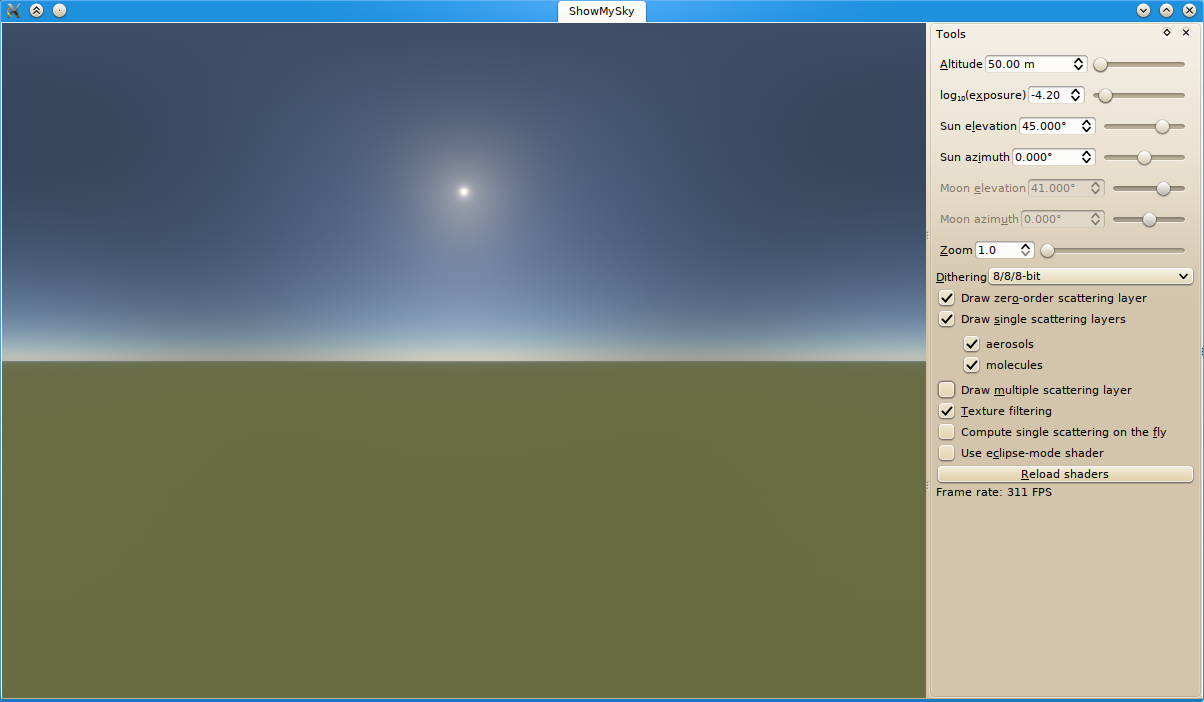The sky does not skip over the green range of frequencies. The sky is green. Remove the scattered light from the Sun and the Moon and even the starlight, if you so wish, and you'll be left with something called airglow (check out the link, it's awesome, great pics, and nice explanation).
Because the link does such a good job explaining airglow, I'll skip the nitty gritty.
So you might be thinking, "Jim, you half-insane ceiling fan, everybody knows that the night sky is black!" Well, you're only half right. The night sky isn't black. The link above explains the science of it, but if that's not good enough, try to remember back to a time when you might have been out in the countryside. No bright city lights, just the night sky and trees. Now when you look at the horizon, can you see the trees? Yes, they're black silhouettes against the night sky. But how could you see black against black? The night sky isn't black. It's green thanks to airglow (or, if you're near a city, orange thanks to light pollution).
Stop, it's picture time. Here's an above the atmosphere view of the night sky from Wikipedia:

And one from the link I posted, just in case you didn't check it out:

See, don't be worried about green. The sky gets around to being green all the time.
First of all, the scheme of only single scattering seems to be an oversimplification: the light direction should be changed more than once. Can we prove that this is negligible by calculation, or is it not negligible?
This is an oversimplification, but for a clear sky at daytime it's not too wrong. See the following comparison of an atmosphere model computed with only single scattering and that including 4 orders of scattering (basically, 4 direction switches per light ray). The projection here is equirectangular, so you can see all the directions in one picture.

This becomes a much more problematic simplification when the sun is under the horizon, particularly noticeable under the belt of Venus, where the Earth's shadow is located:

Assuming the sun is in zenith, it follows from symmetry that the color of the sky in the directions having the same zenith angle must be the same, but closer to the horizon the way of the scattered light differs a lot from the rays coming near zenith — so is it possible to derive theoretically a formula which would predict the color of sky given the azimuth angle and the position of the Sun (at least in a simple geometrical setup when the Sun is in zenith)?
If we neglect non-uniformity of the atmosphere with latitude and longitude, this scenario will lead to the colors independent of azimuth. It's not quite clear what you mean by "position of the Sun" though, if you already put it into zenith. Also, if by "derive theoretically a formula" you mean some closed-form expression, then it's unlikely, given that the atmosphere is not a simple distribution of gases and aerosols. But it's possible to calculate the colors numerically, and the above pictures demonstrate this calculation done by my (work in progress) software, CalcMySky.
It's not clear why the color should not rapidly change from near blue at horizon to almost red near the Sun position: after all, the atmosphere is thicker along the lines going closer to horizon!
It shouldn't be bluer at the horizon than at the zenith. After all, you have relatively small thickness near zenith, which makes most of the light scattered to you not too extincted due to Beer-Lambert law, while near the horizon the thickness is much larger, and the light scattered into the observer, in addition to becoming bluer due to Rayleigh scattering depending on wavelength, becomes also redder due to extinction along this long path. The combination of this bluing and reddening effects gives a color closer to white (which you can see in the daytime simulation above), or reddish-orange (in the twilight).
Further, it follows from the usual explanation that blue light is partially reflected back into the space. Due to this, about half of all scattered light should be lost, so the total amount of red light coming from sun should be greater than the amount of blue light, which seems to contradict the observable reality.
Yes, the Earth indeed looks bluish from space, so the total radiation incoming from above should be redder at the ground level than at the top of atmosphere. But this is modified by the ozone layer, without which we'd have sandy color of twilight instead of blue. See for details the question Why is there a “blue hour” after the “golden hour”?




Best Answer
The surface brightness of the Sun is -10.6 mag per square arcsecond.
The full moon on the other hand is about 14.5 (astronomical) magnitudes fainter than the Sun, has a similar apparent angular size and is just visible in a bright daytime sky.
The flux from the daylight sky incident upon the eye is therefore around $10^{14.5/2.5}$ times less than the solar constant. i.e. About $2\times 10^{-3}$ W/m$^2$.
The pupils of the eye might have a 2mm diameter in bright light, so receive around $6.2\times 10^{-9}$ W.
Let's assume that the average blue sky photon is at 400 nm with an energy of 3.1 eV, then you receive about $10^{10}$ per second (in each eye).
Ah, but this would be correct for a small patch of blue sky with the same angular extent as the full moon (about $7\times 10^{-5}$ steradians). The eye actually collects light from $\sim \pi$ steradians, but then the projected area of the pupil is reduced by a small factor (I think 0.75) because of the $\cos \theta$ term.
So the final result is $3\times 10^{14}$ photons per eye.